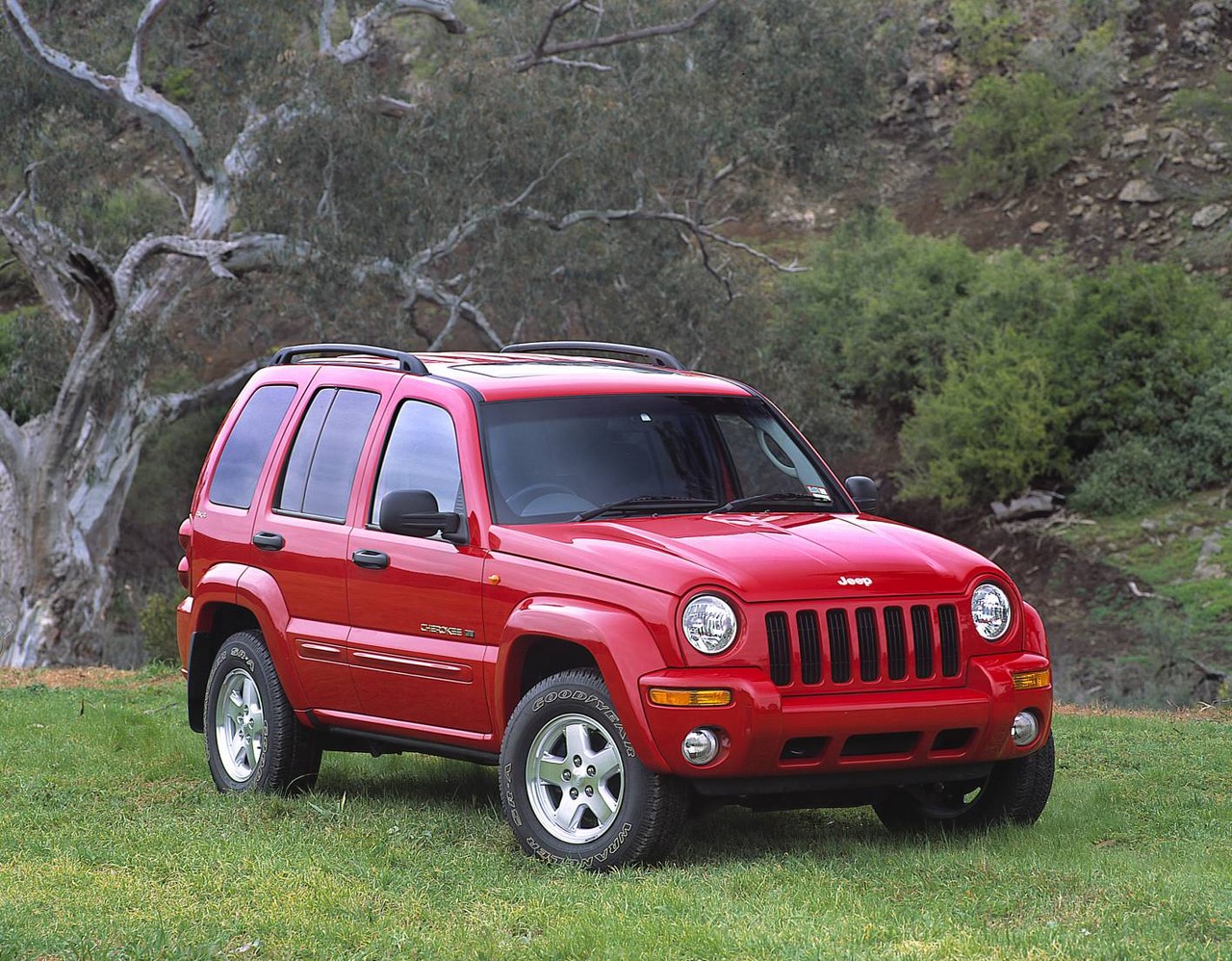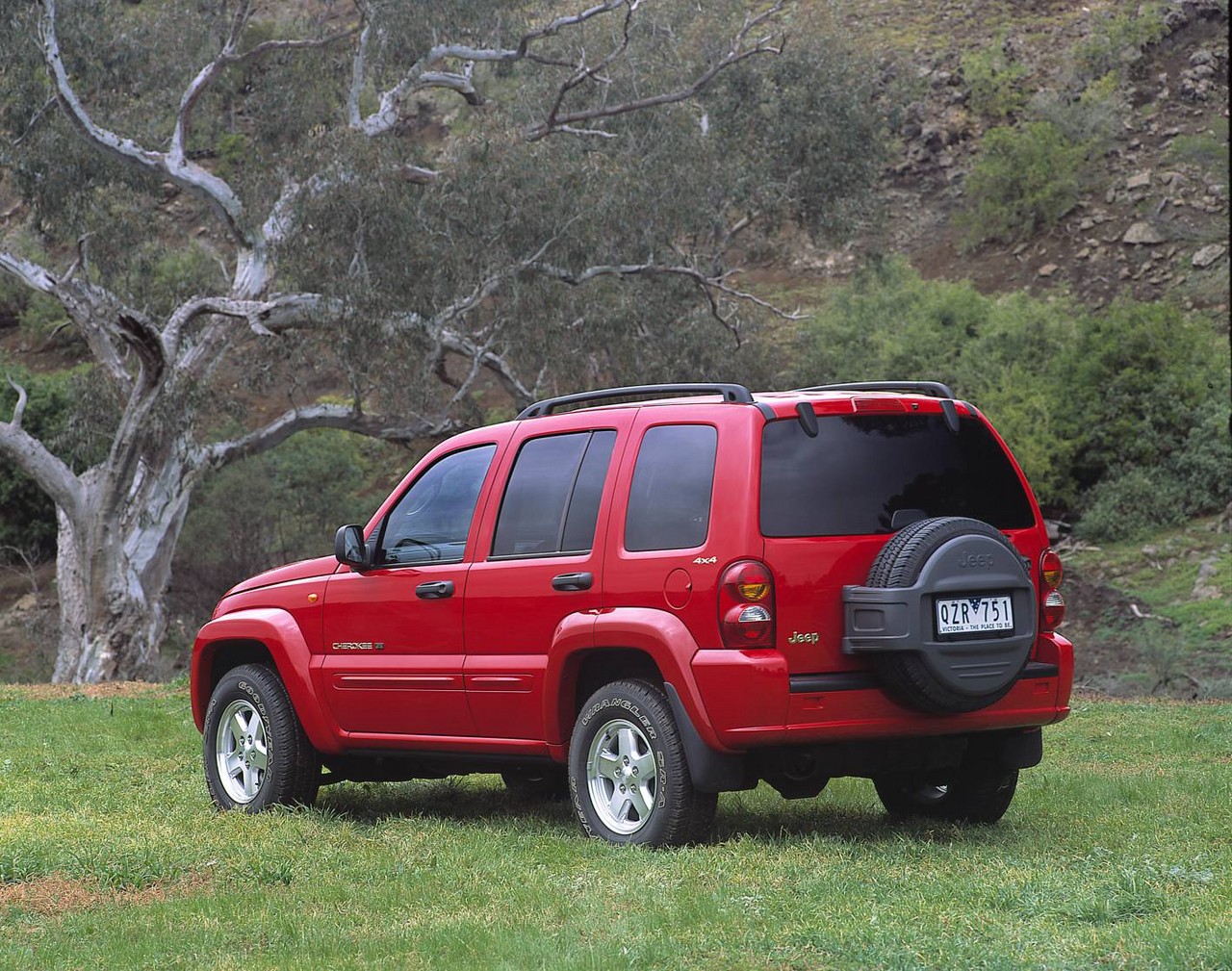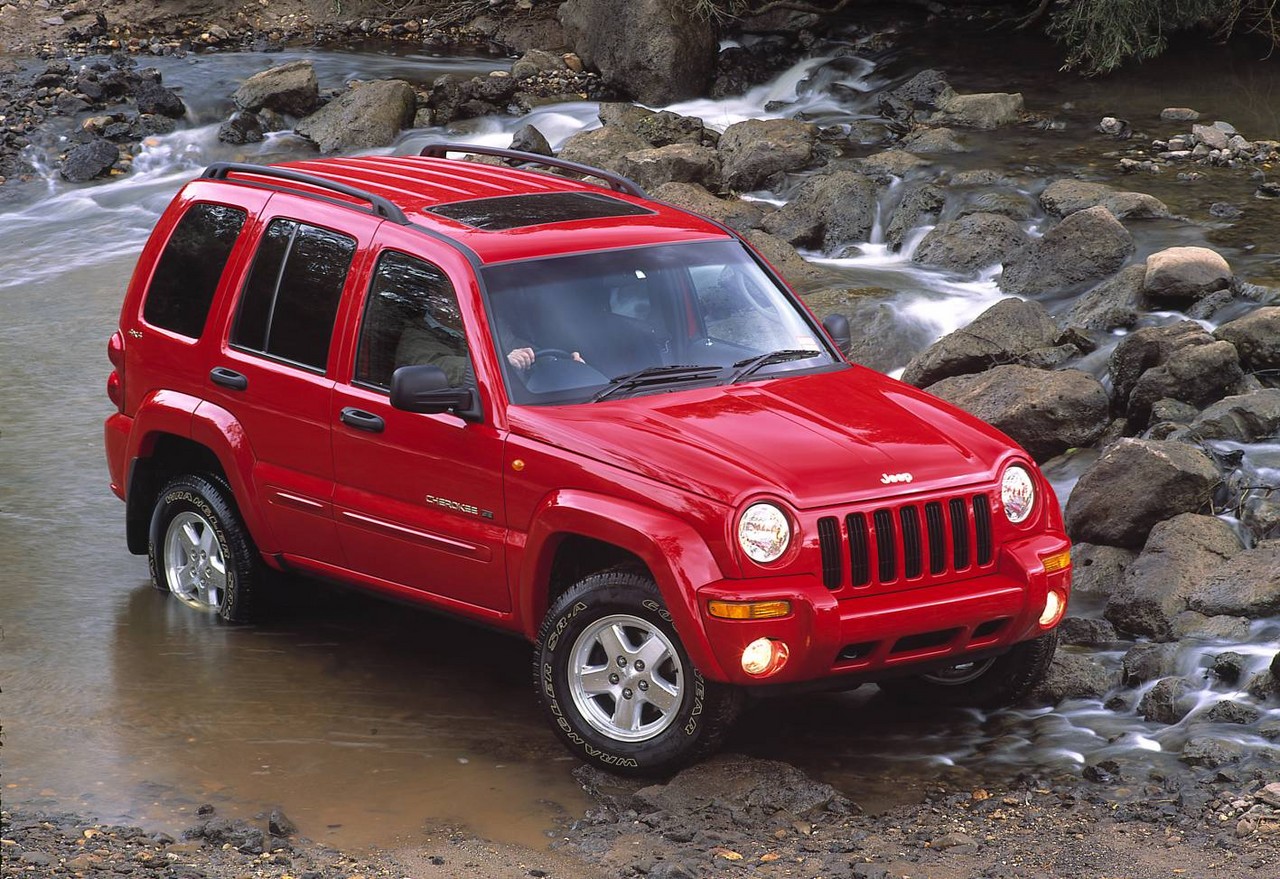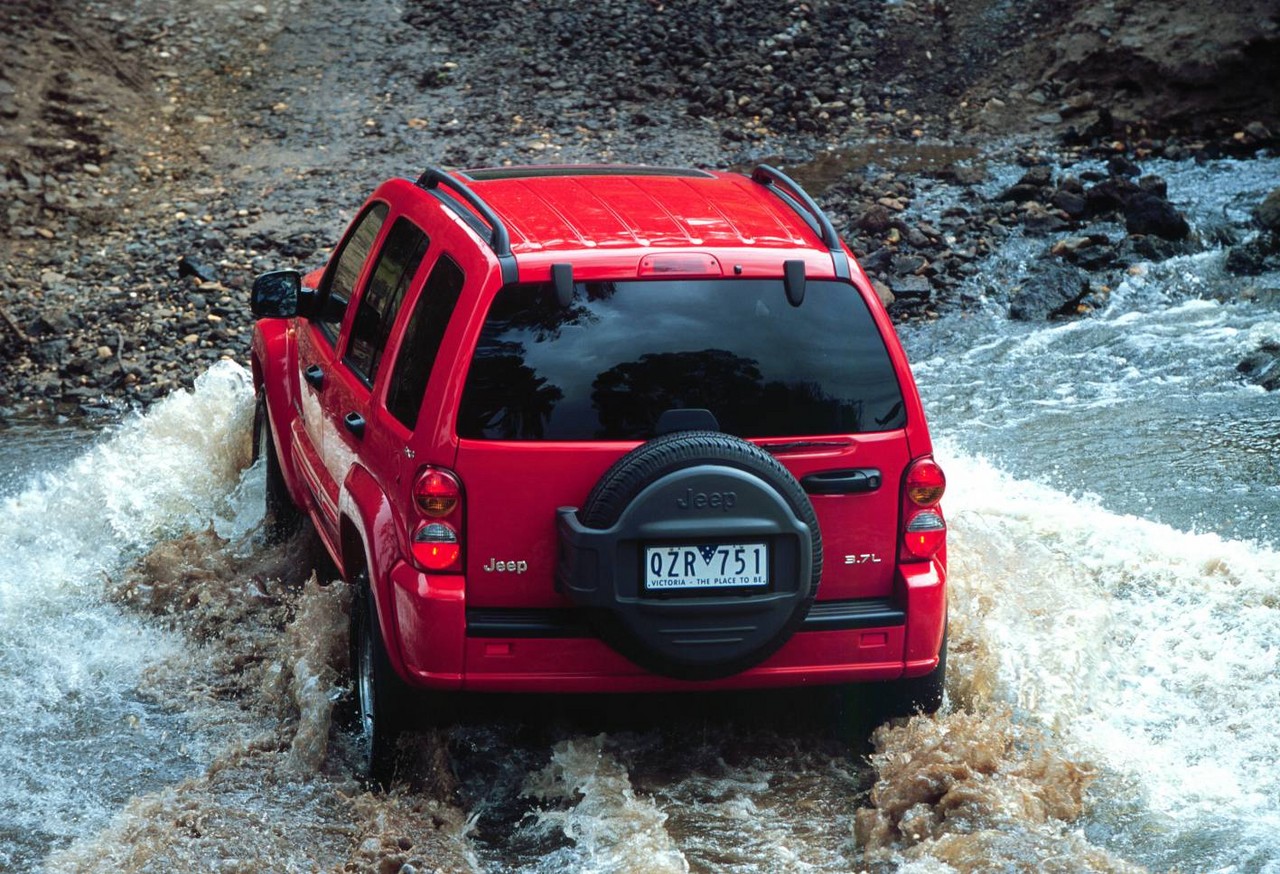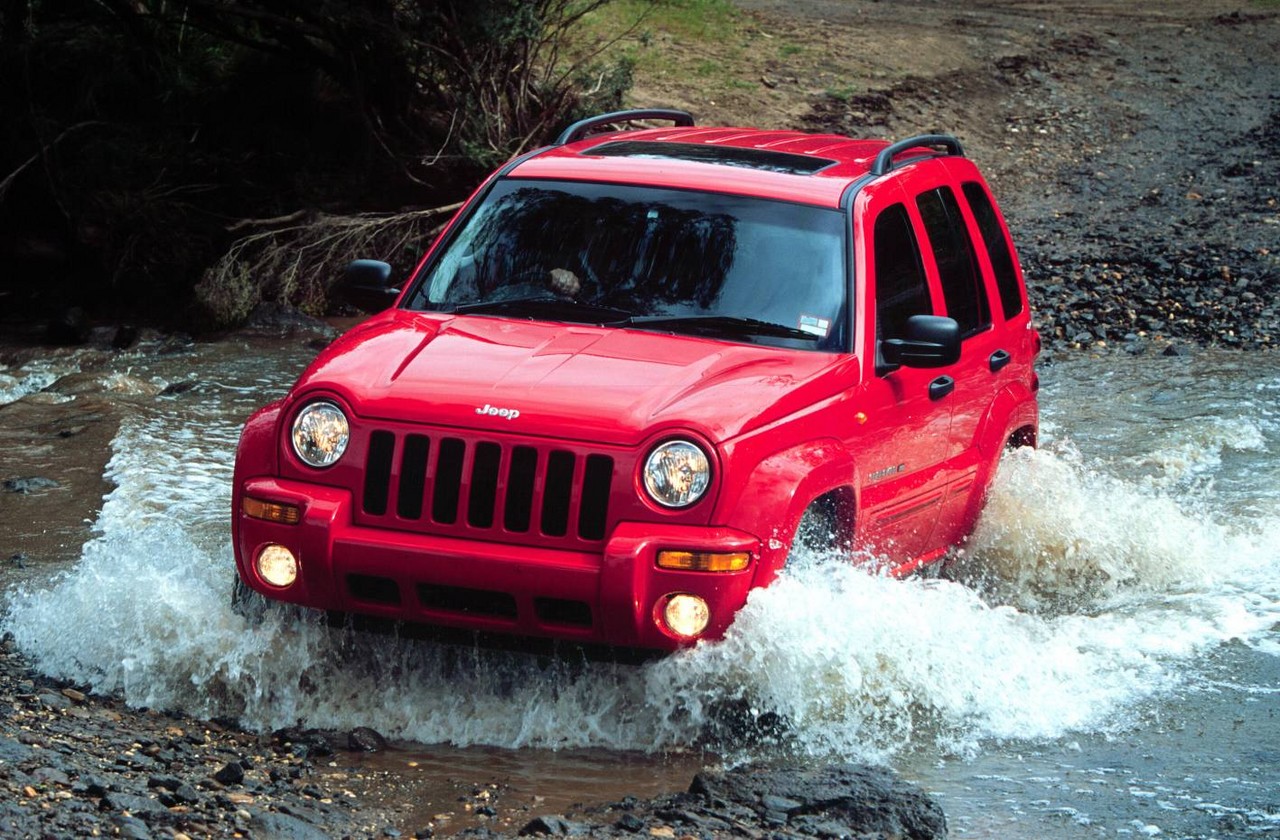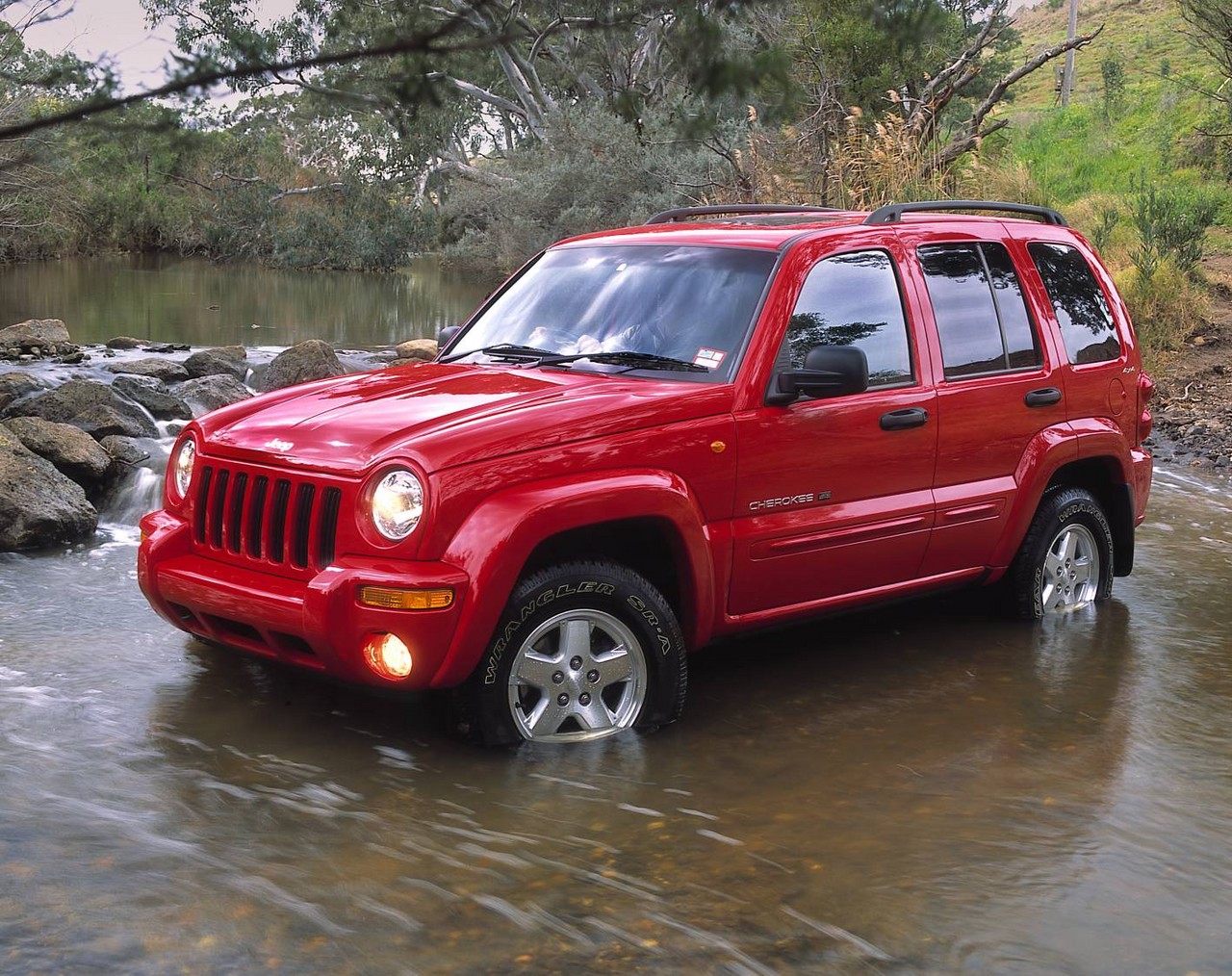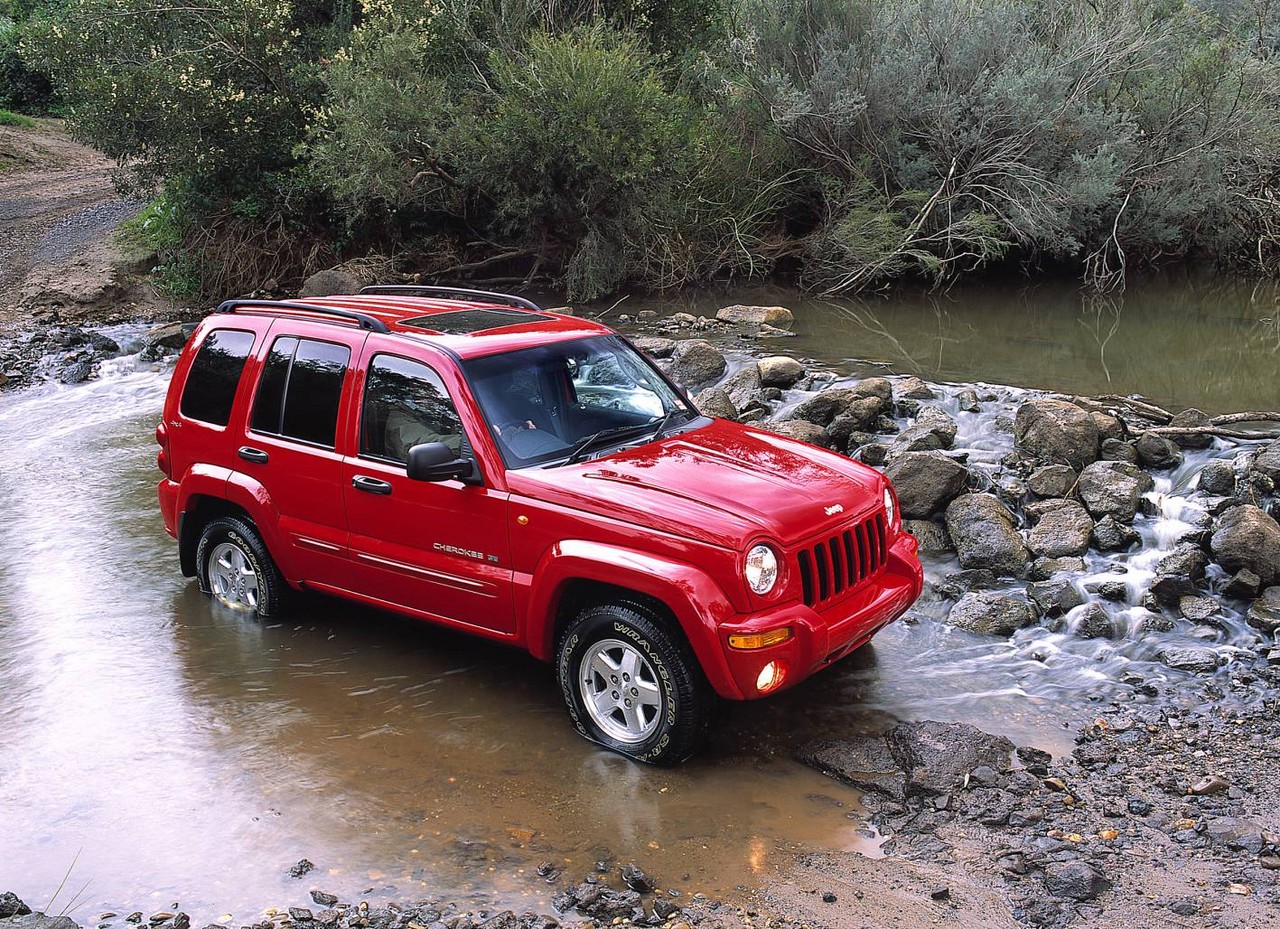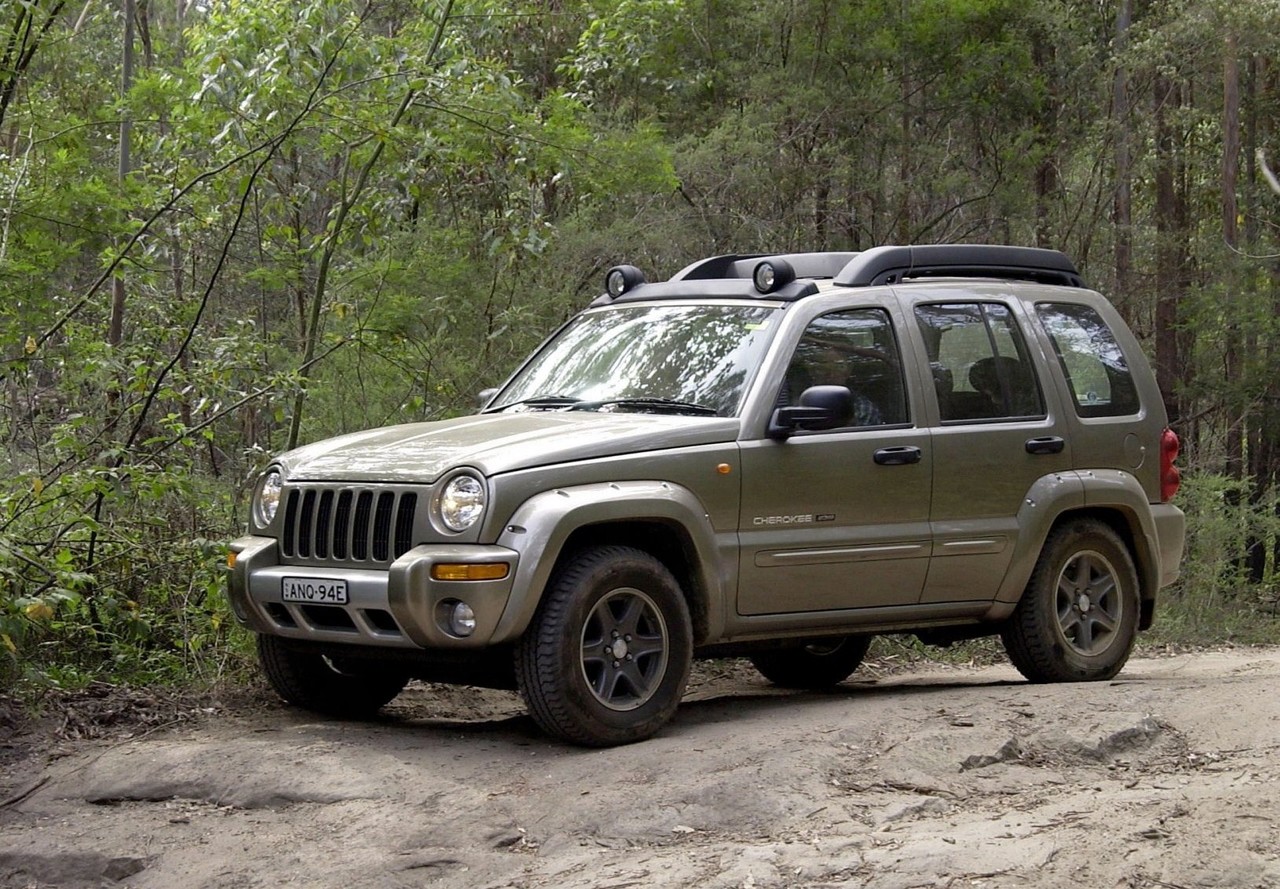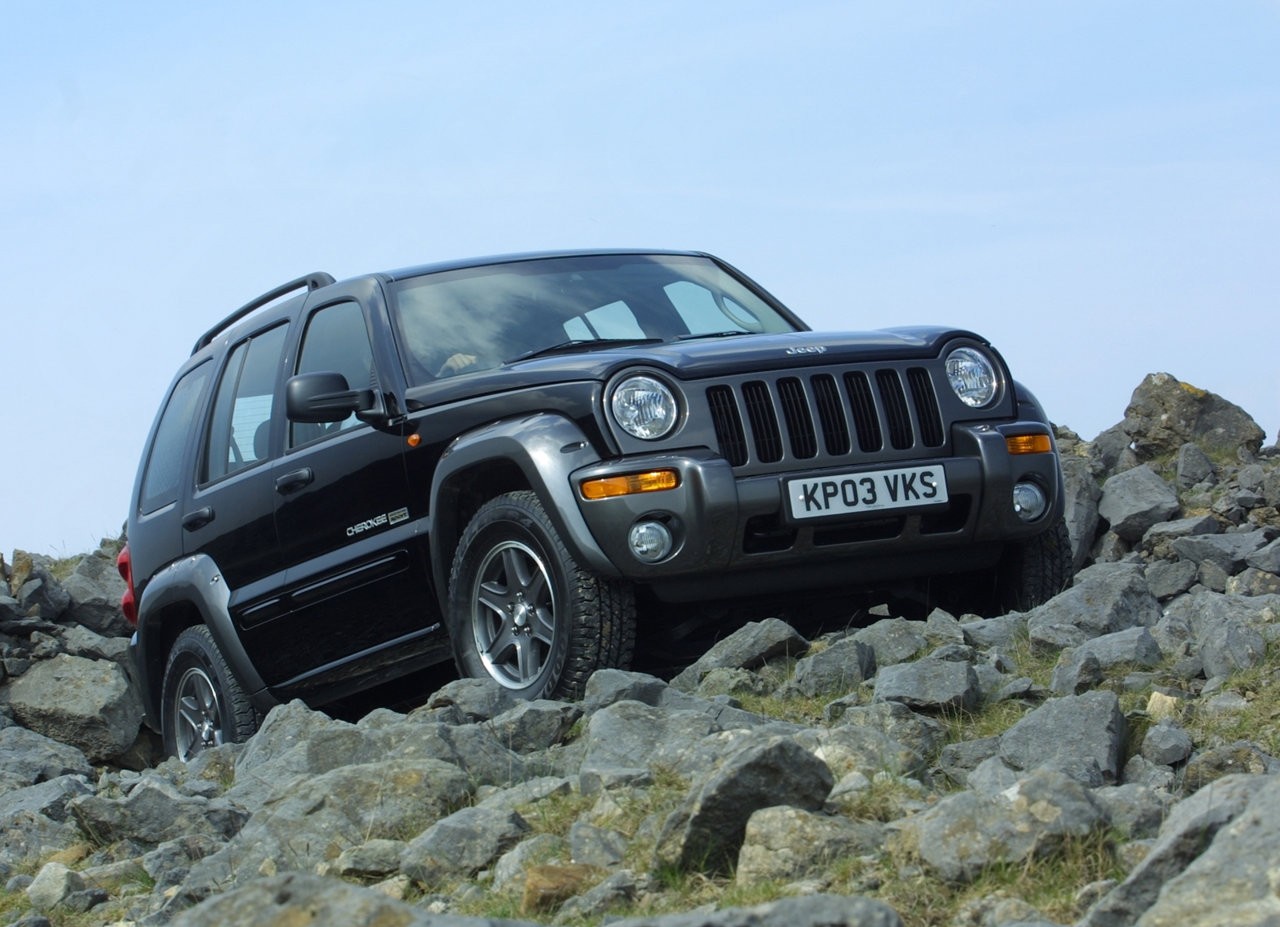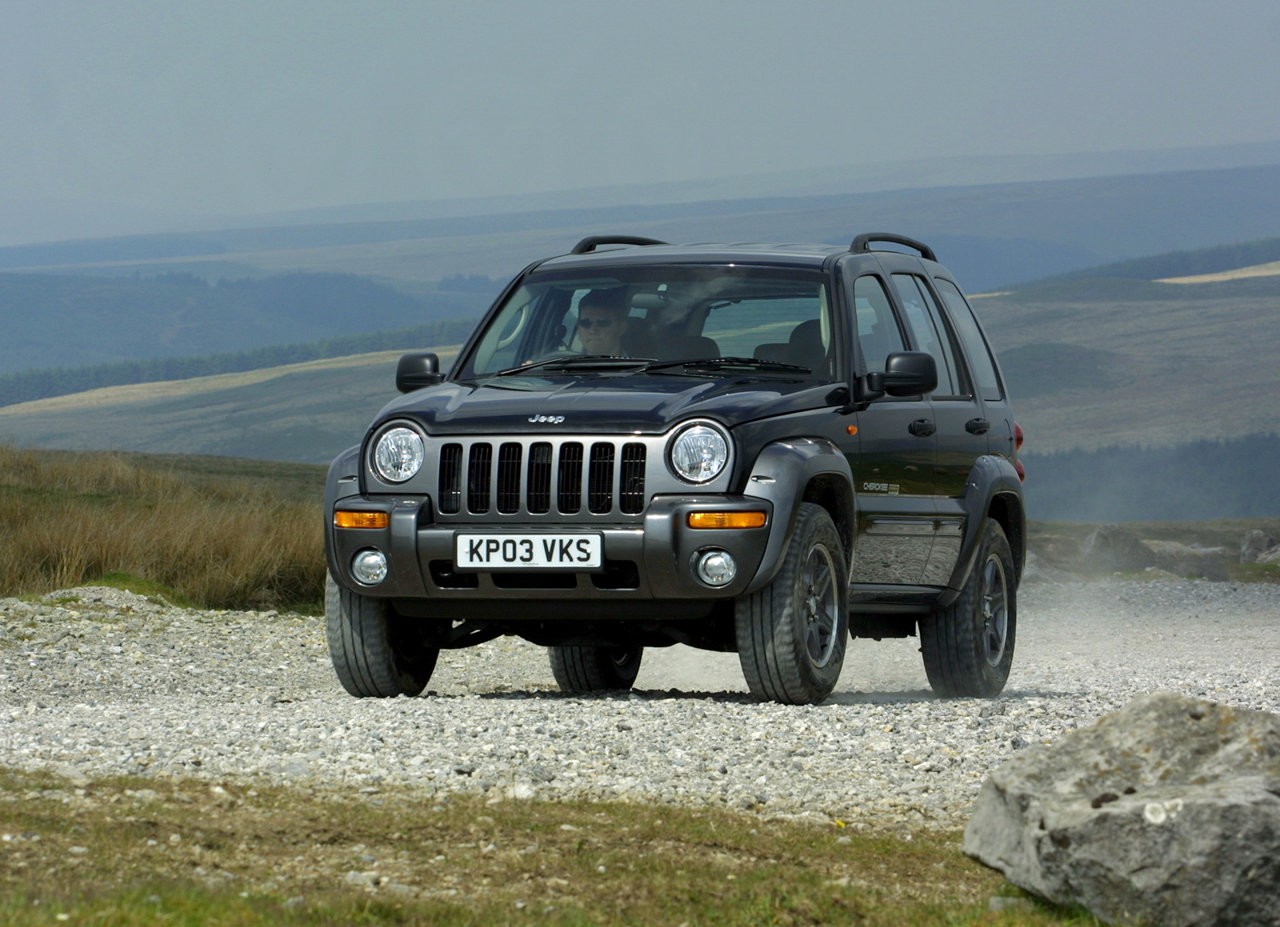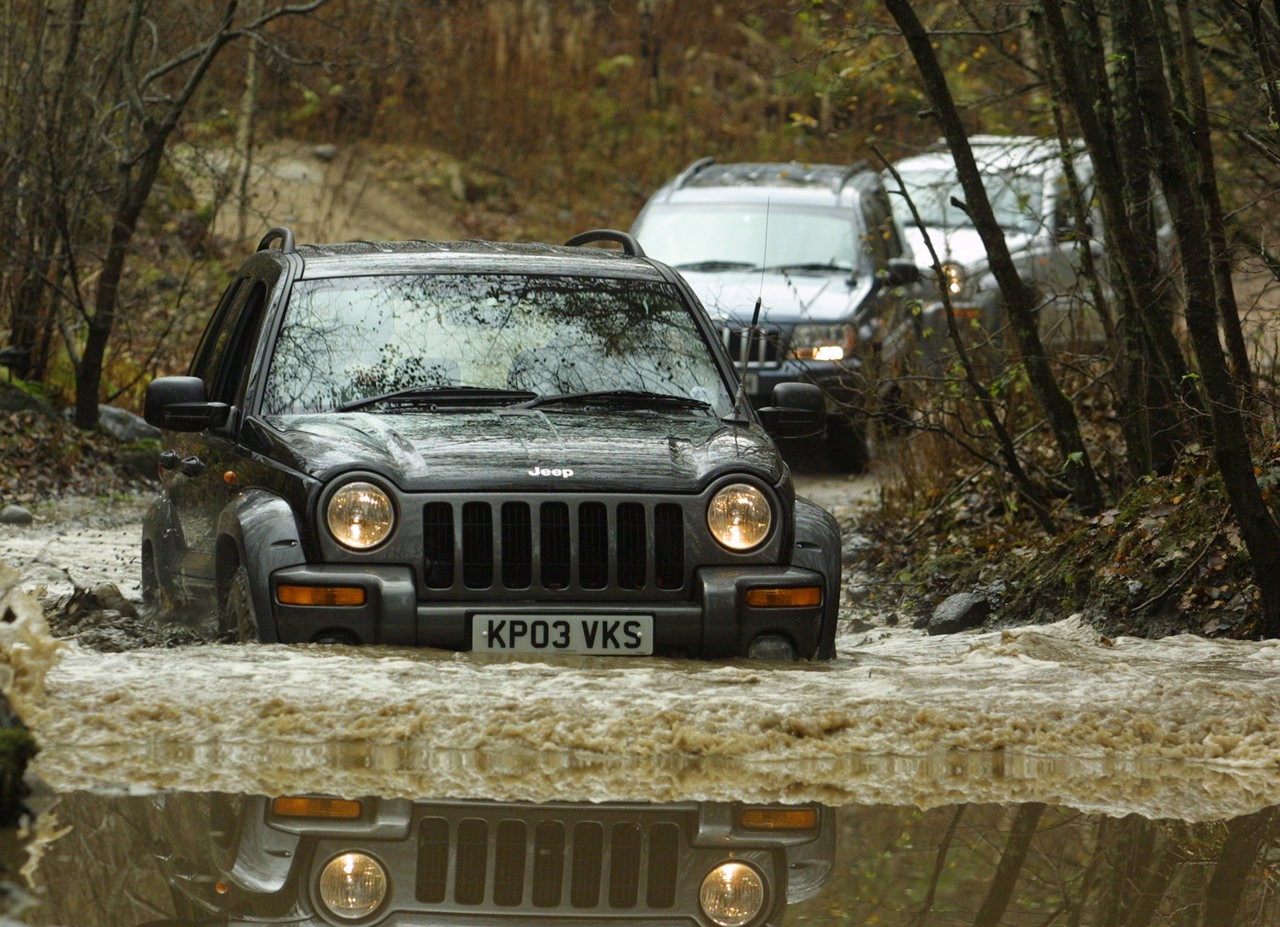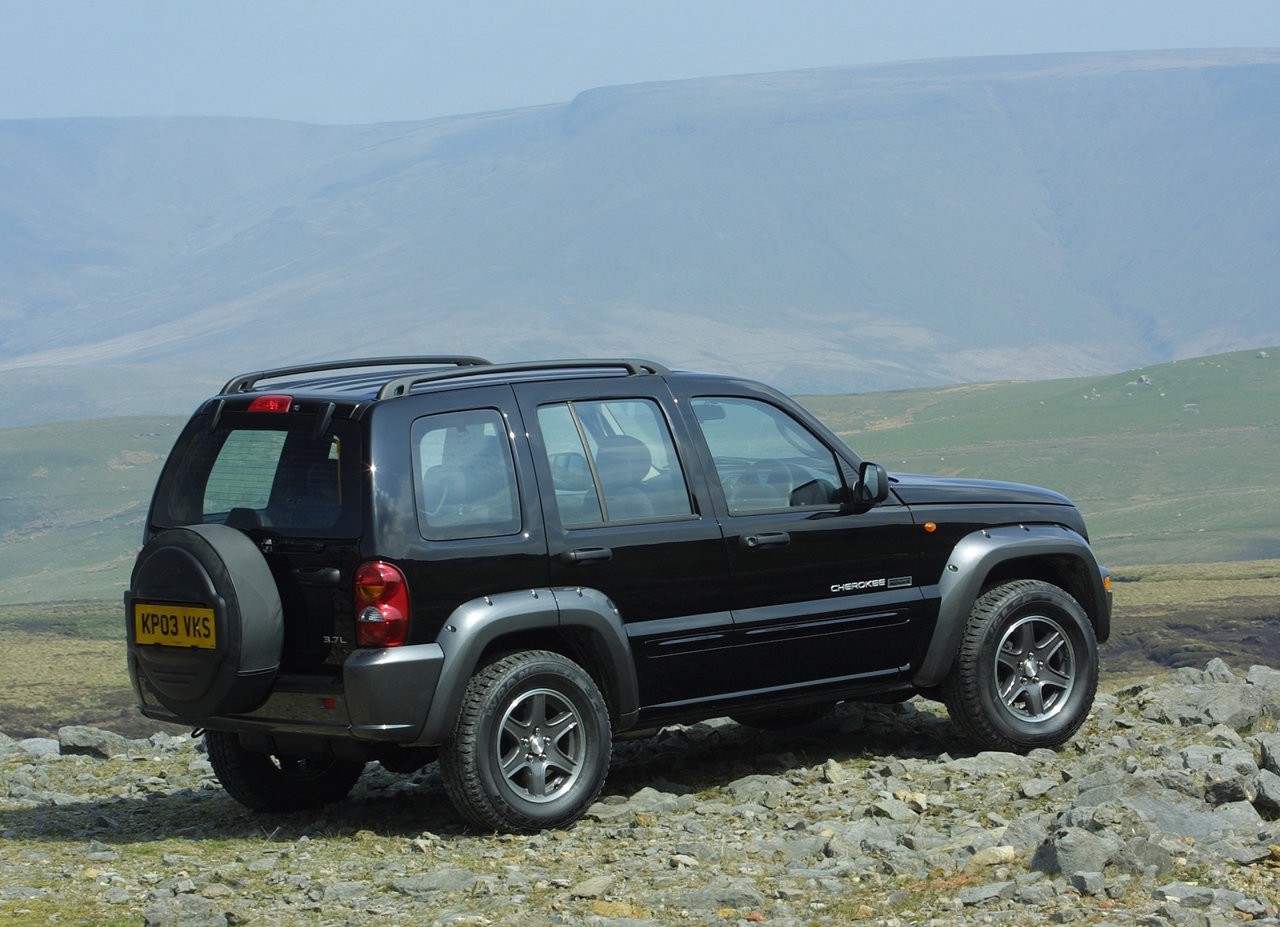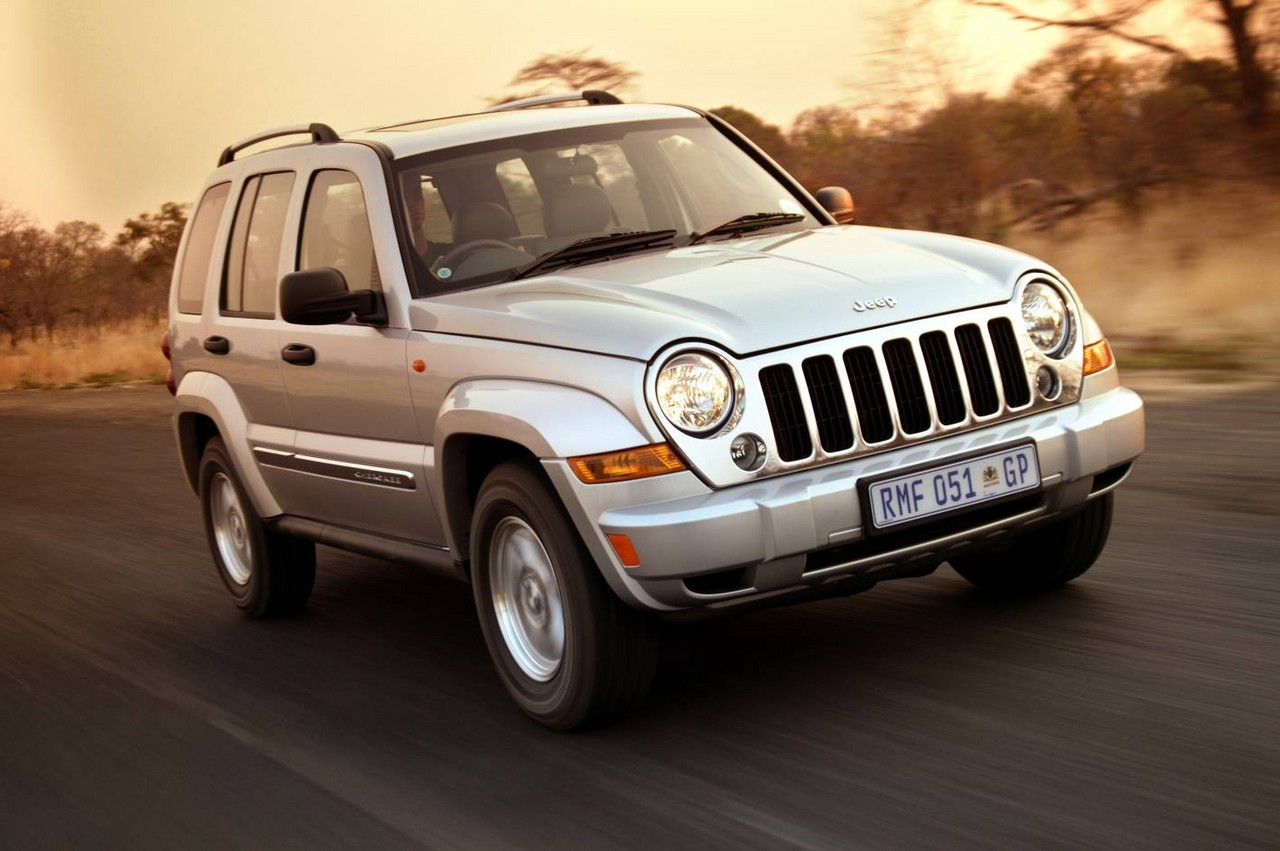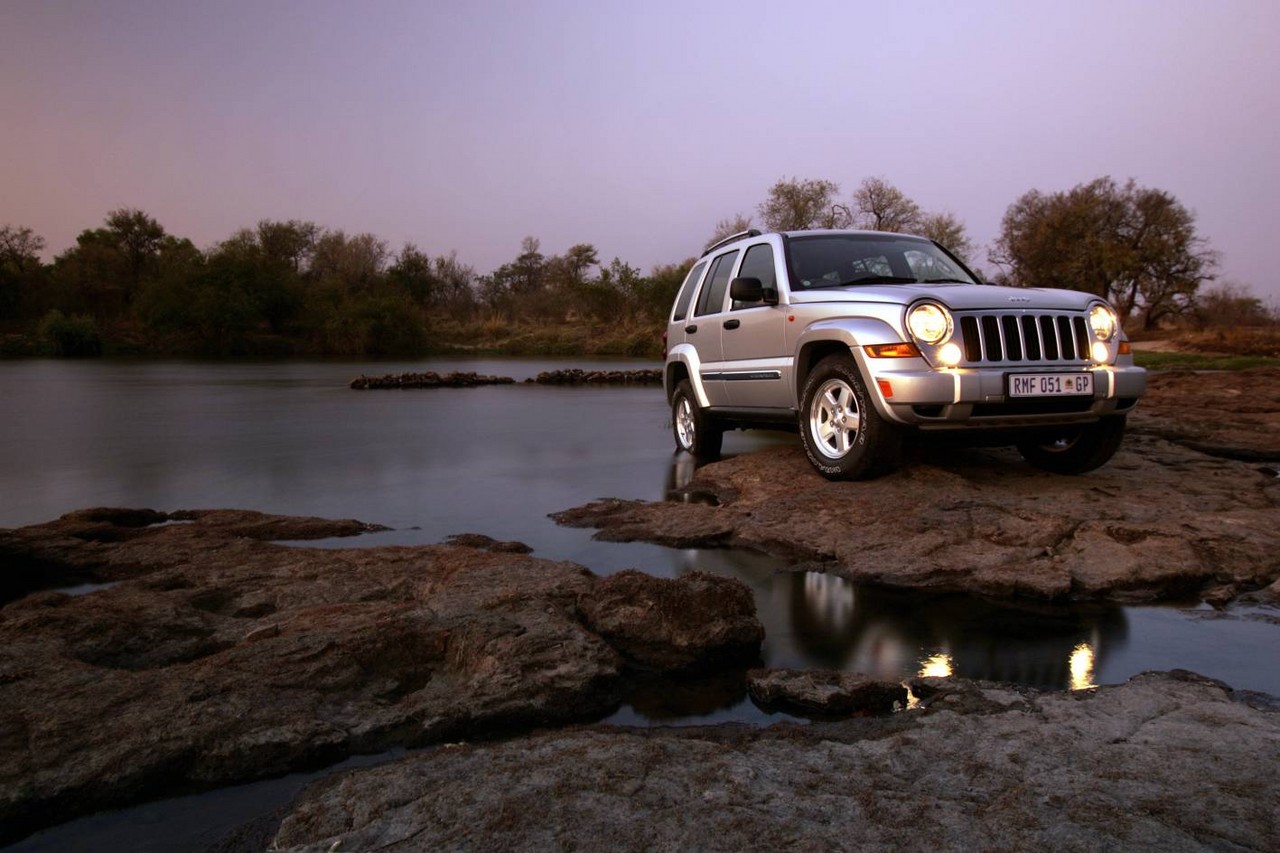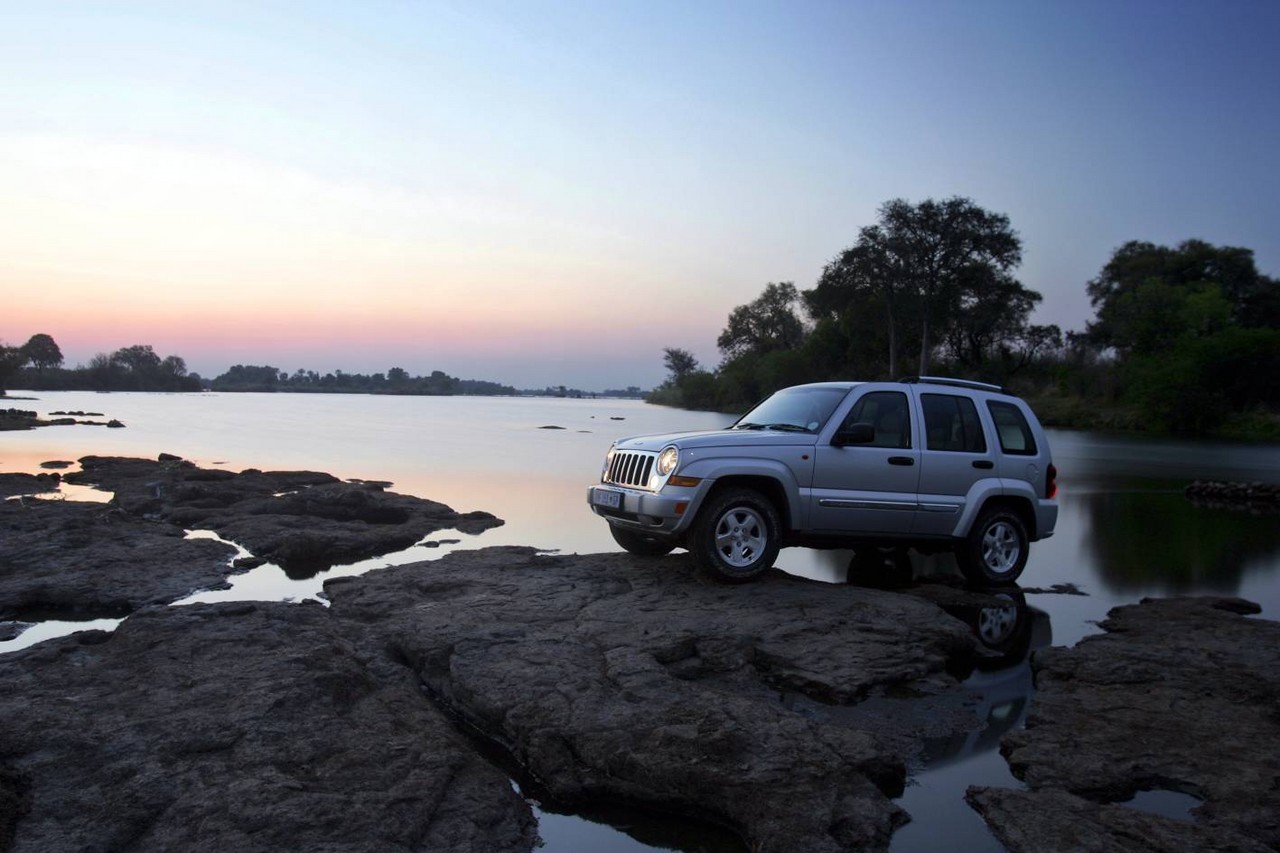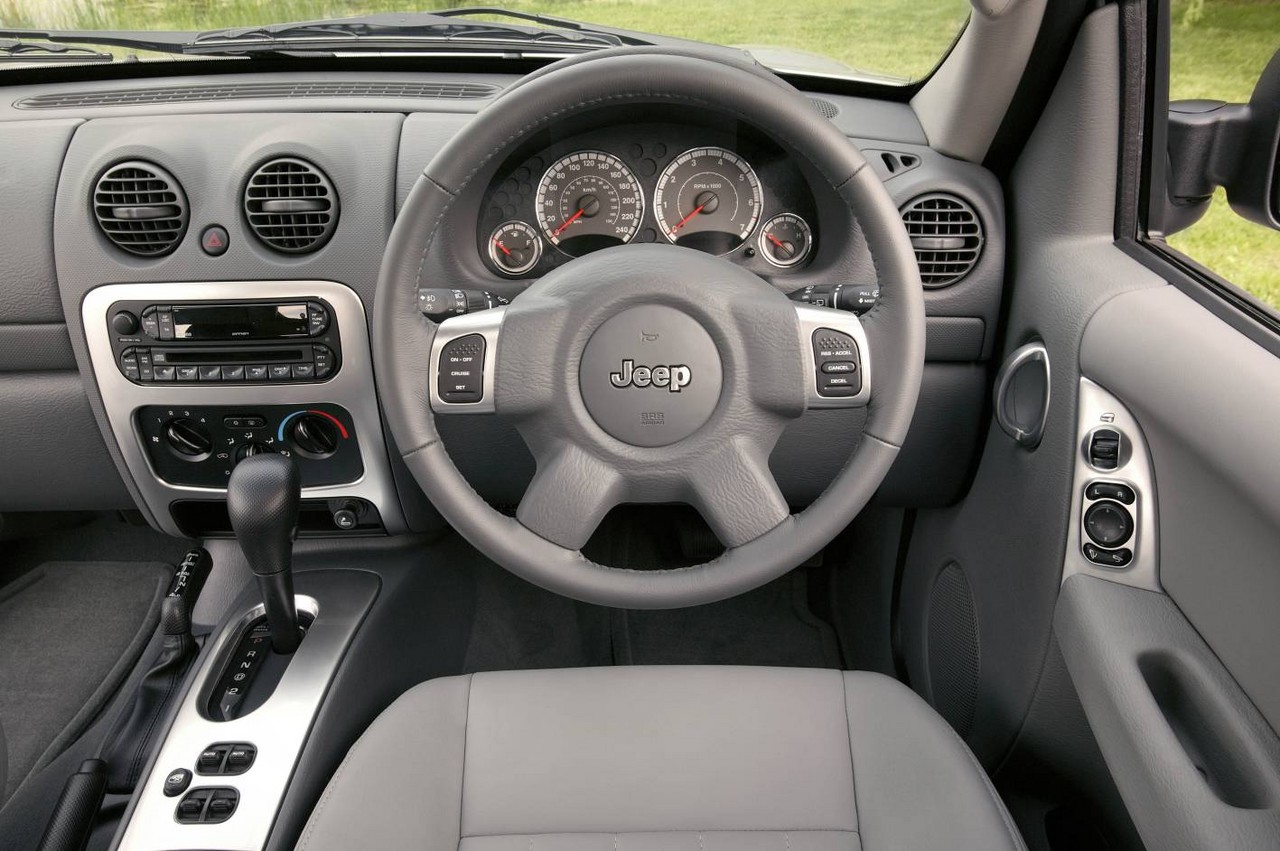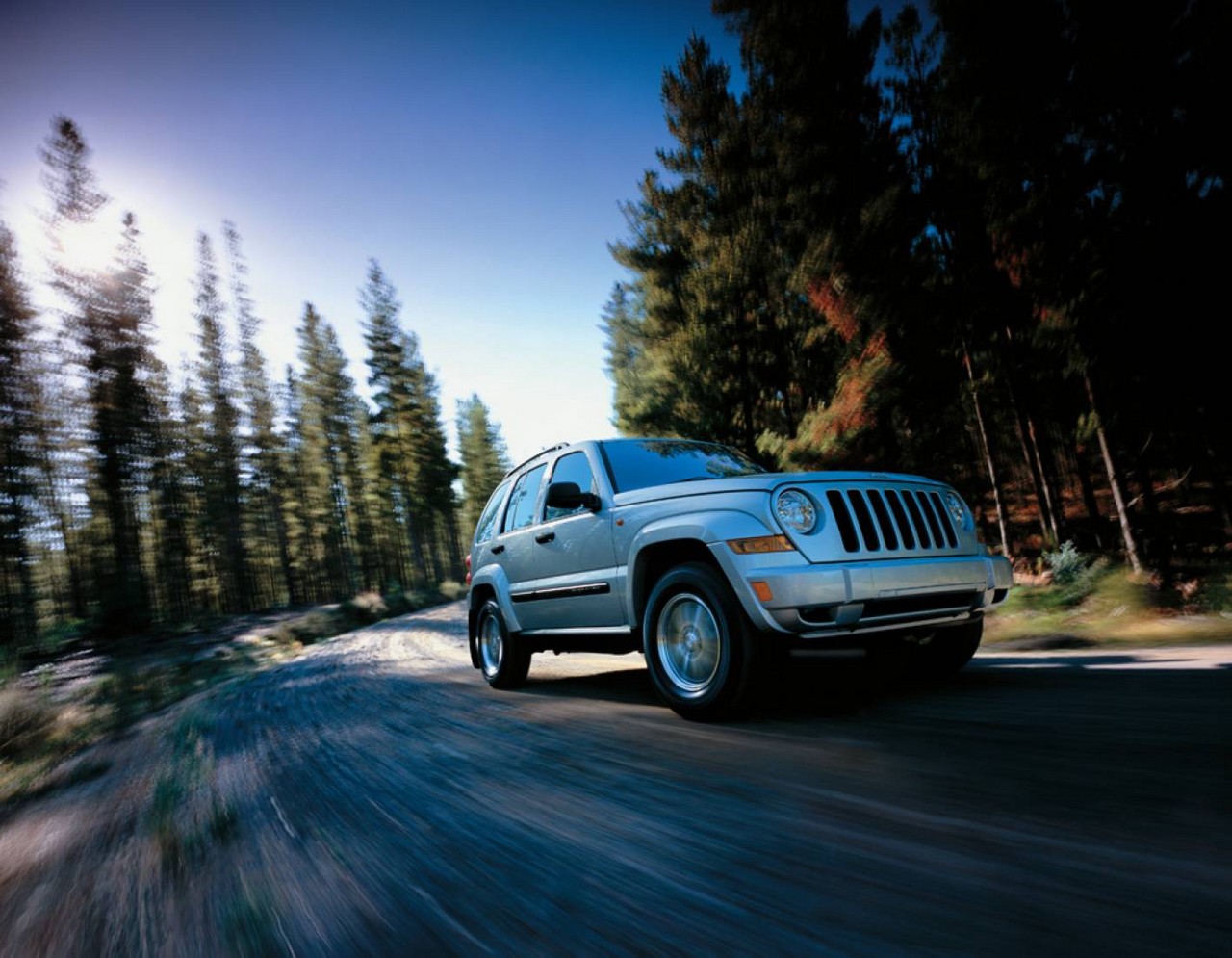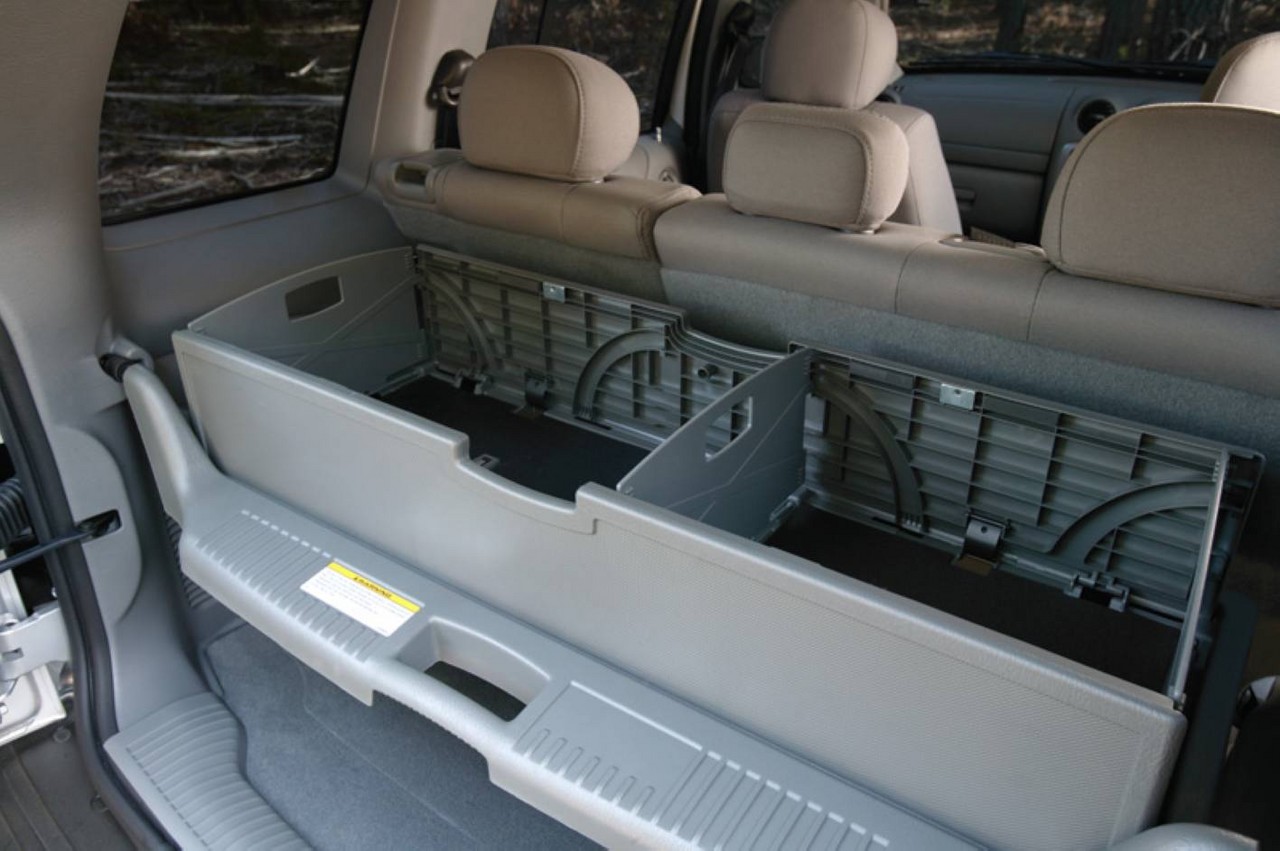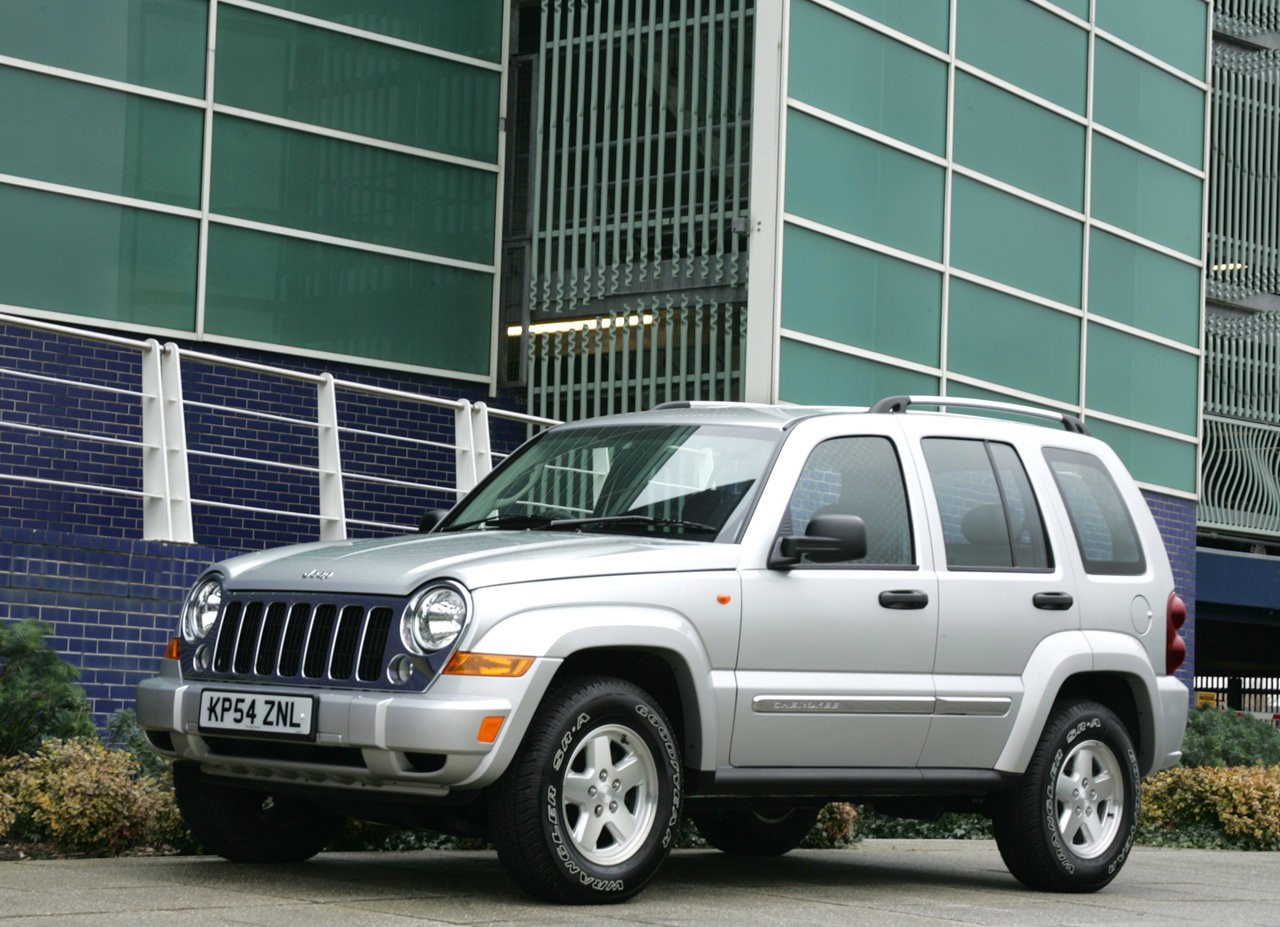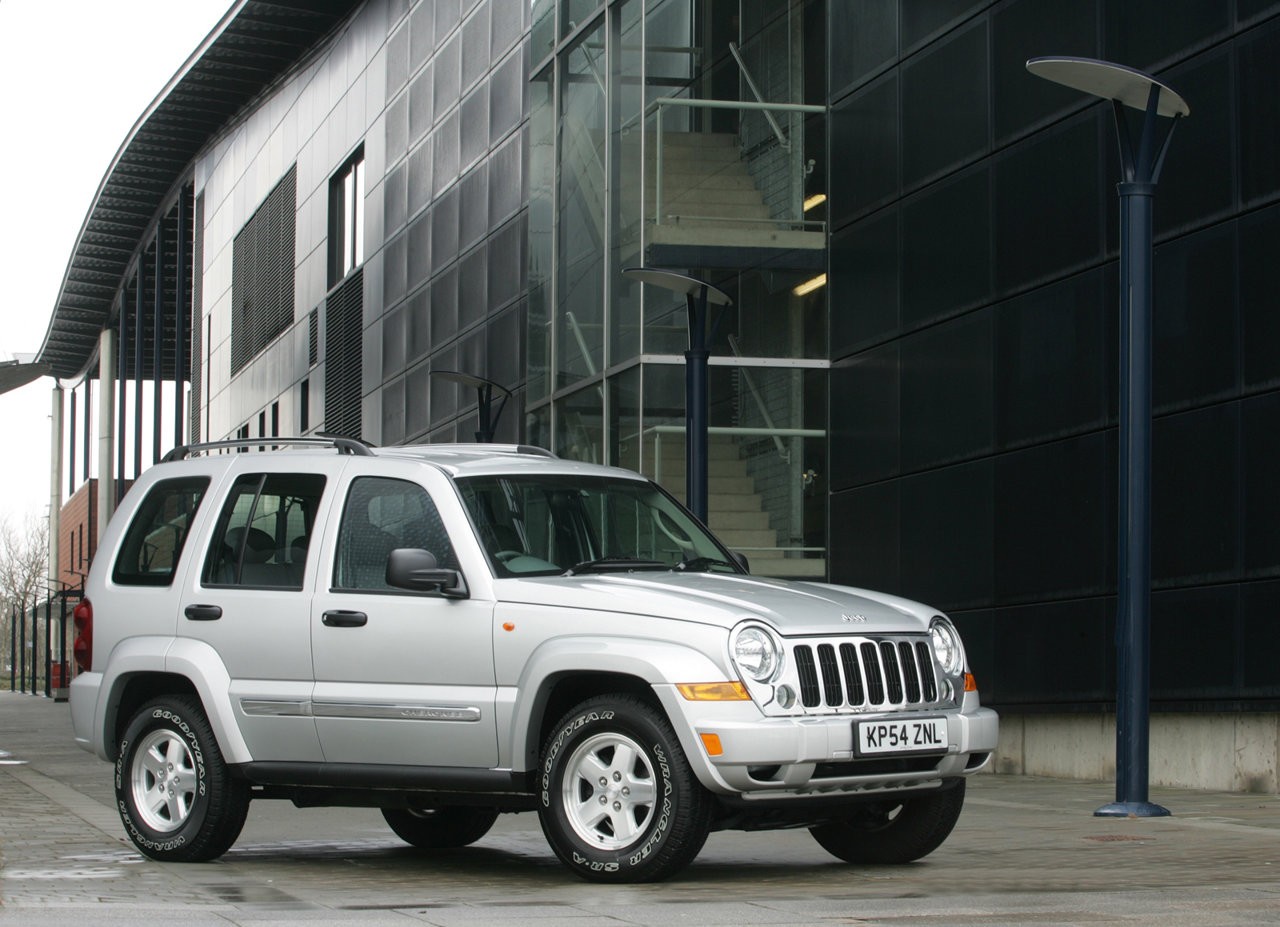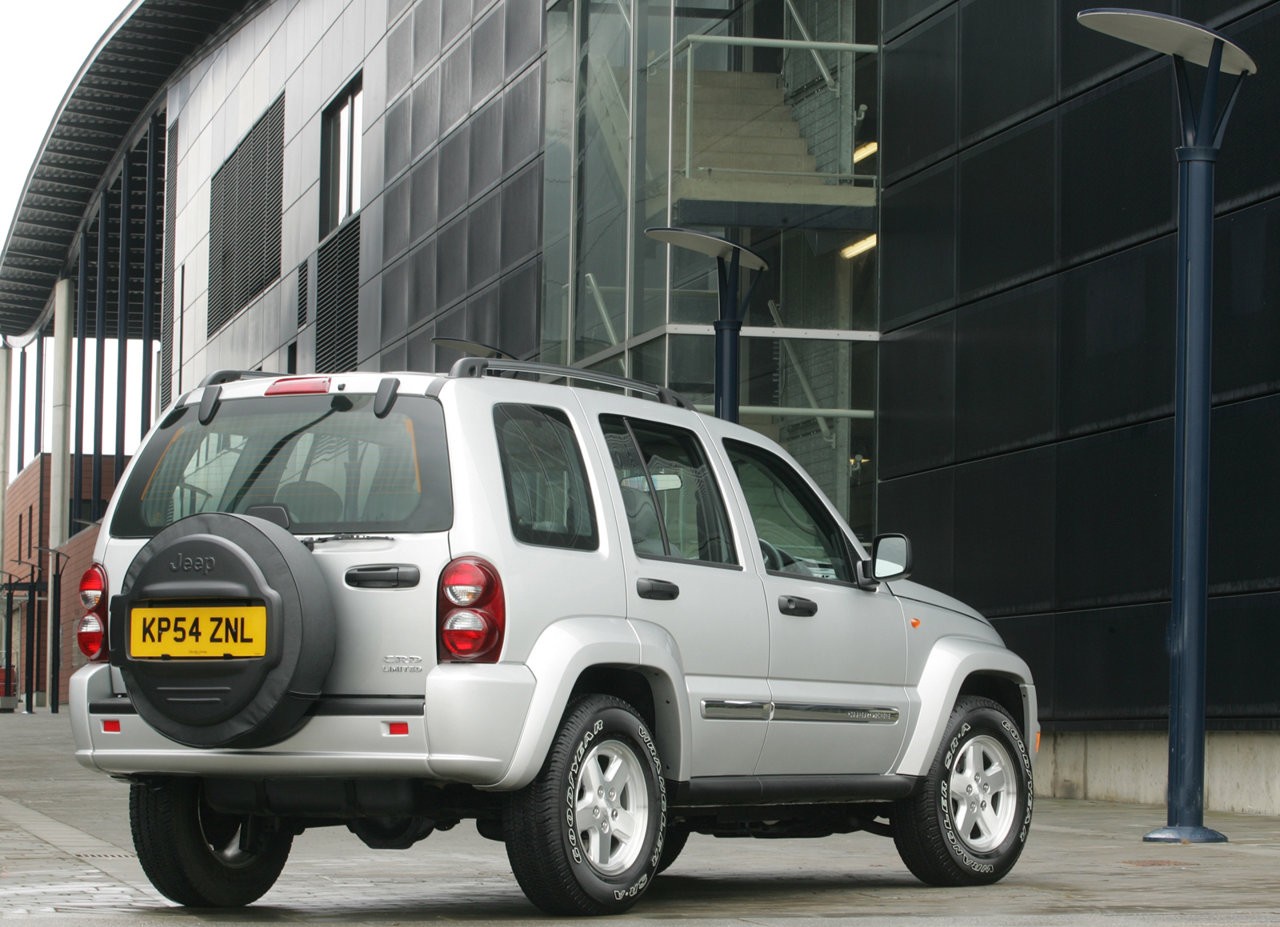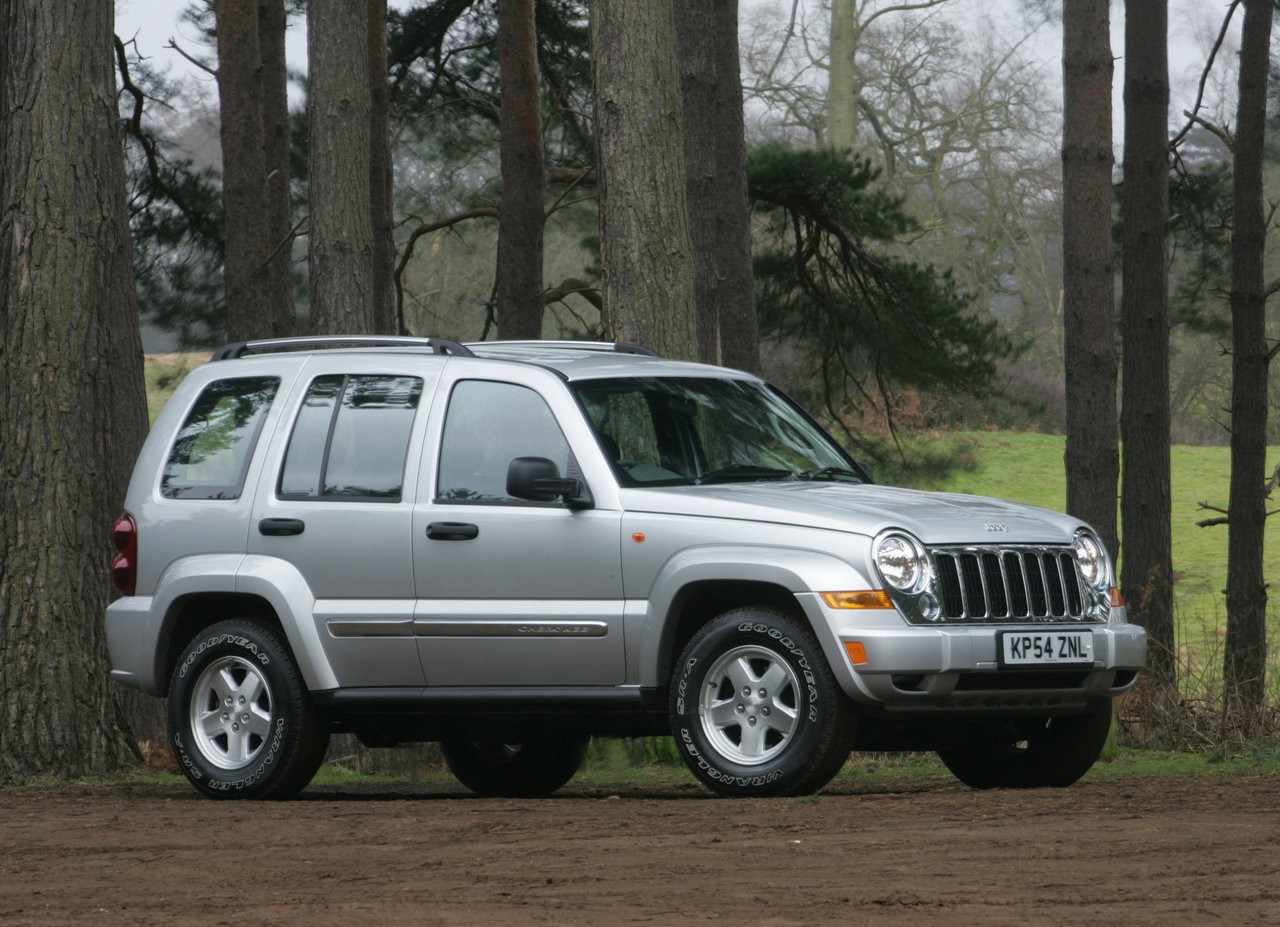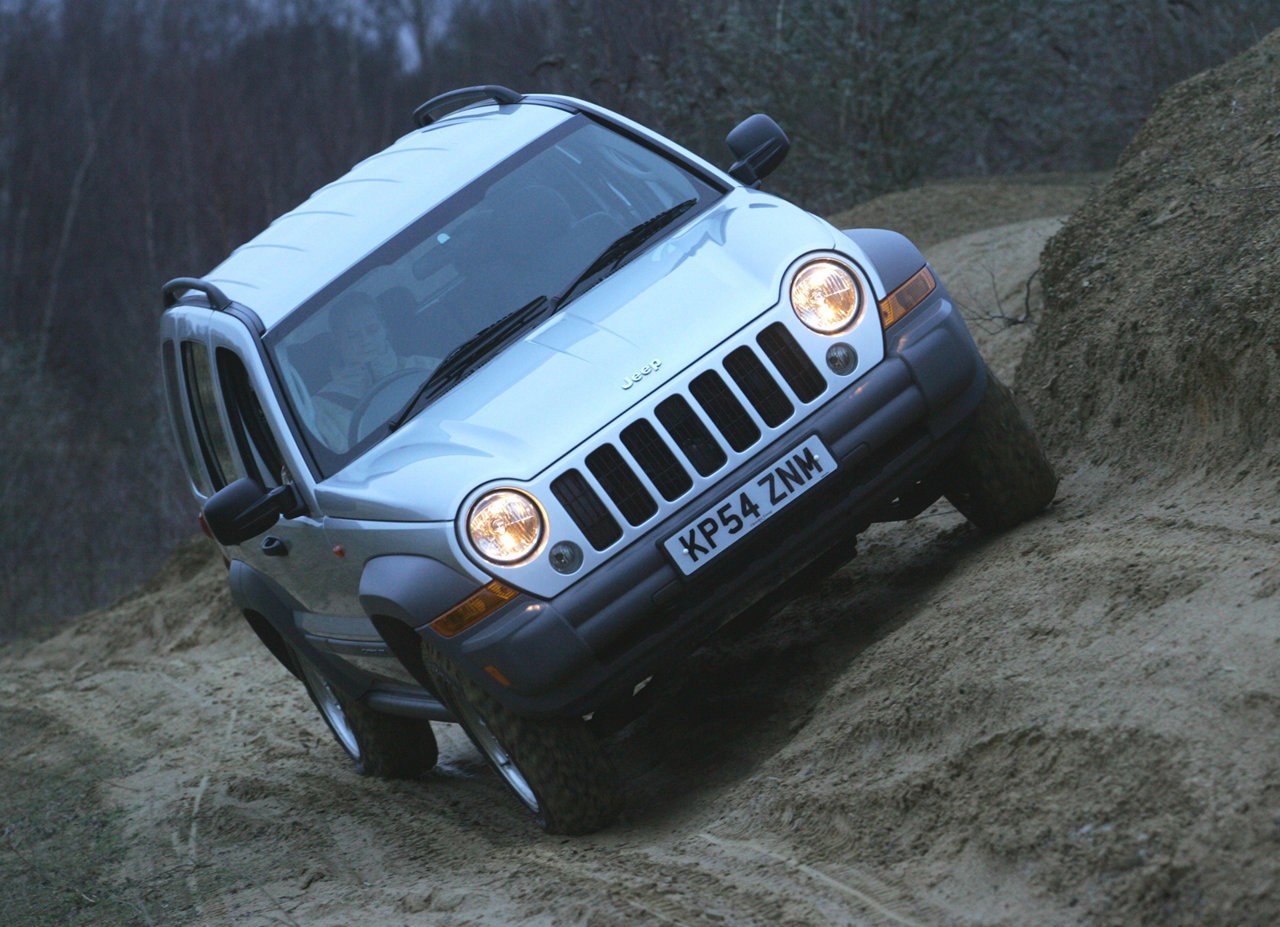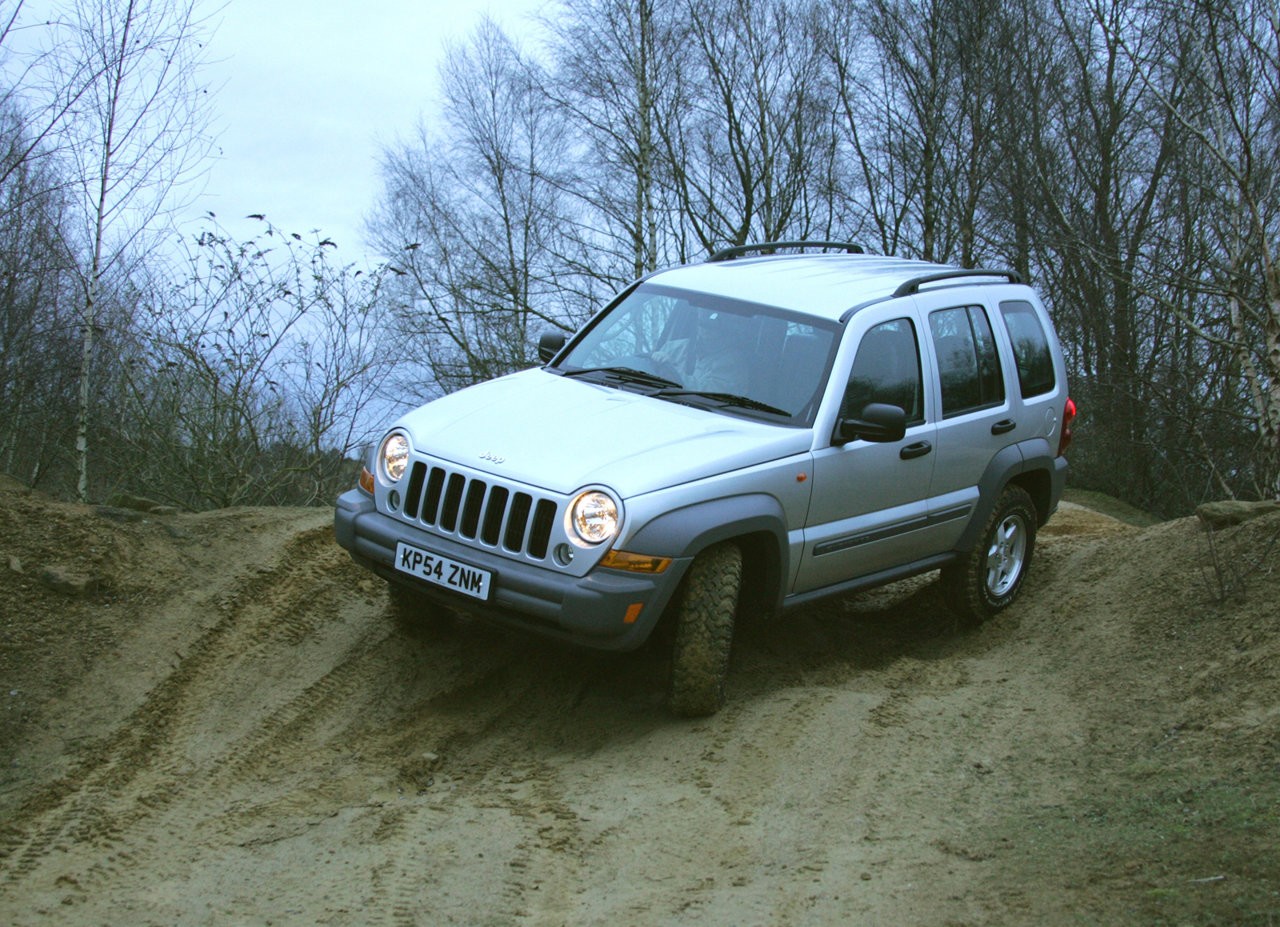
- Refined 3.7-litre V6 petrol engine
- Economical turbo-diesel engines
- Comfortable ride
- Off-road capability
- Underpowered 2.4-litre petrol engine
- Below average interior fit and finish
- Weak headlights
- Lack of adjustment for driver’s seat
- Small load area
Review: Jeep KJ.I Cherokee (2001-04)
Overview
Released in October 2001, the Jeep KJ Series I (KJ.I) Cherokee was a 4WD wagon. Manufactured in Ohio, USA, the KJ.I Cherokee was initially available with either a 2.5-litre turbo-diesel engine (the ‘2.5L CRD’ variants) or a 3.7-litre V6 petrol engine (the ‘3.7L V6’). In March 2003, the 2.5L CRD was replaced by the 2.8L CRD; in 2004, an entry-level model was introduced with a 2.4-litre petrol engine. The full range is given in the table below.
Engines: Diesel and Petrol
Of the engines,
- the 2.5-litre VM Motori R425 turbo-diesel engine had a cast iron block and aluminium heads, common-rail direct fuel injection, double overhead camshafts, four valves per cylinder and a compression ratio of 17.5:1. The 2.8-litre VM Motori R428 turbo-diesel engine had the same specifications properties;
- the 2.4-litre PowerTech petrol engine had double overhead camshafts, four valves per cylinder and a compression ratio of 9.5:1; and,
- the 3.7-litre V6 petrol engine had a cast iron block with aluminium heads, a single overhead camshaft, two valves per cylinder and a compression ratio of 9.1:1.
While the automatic transmission mated to the 3.7-litre V6 engine was officially described as a four-speed, it had five effective ratios due to an alternative second gear ratio for downshifts.
Dimensions and suspension
The KJ Cherokee had a ladder-frame chassis and was 4496 mm long, 1819 mm wide, 1866 mm tall (including roof racks) and had a 2649 mm long wheelbase; ground clearance was 203 mm. Furthermore, the KJ Cherokee had independent front suspension with upper and lower A-arms and a live rear axle with a trailing upper A-arm and dual trailing lower arms; both front and rear suspension had coil springs, gas-charged shock absorbers and stabiliser bars.
| Variant | Engine | Editions | Year | Trans. | Peak power | Peak torque |
|---|---|---|---|---|---|---|
| 3.7L V6 | 3.7-litre petrol V6 | Sport, Limited |
2001-04 | 4sp auto | 155 kW at 5200 rpm | 312 Nm at 3800 rpm |
| Renegade | 2002-03 | |||||
| 2.5L CRD | 2.5-litre turbo-diesel I4 | Sport | 2001-03 | 5sp man. | 105 kW at 4000 rpm | 343 Nm at 2000 rpm |
| 2.8L CRD | 2.8-litre turbo-diesel I4 | Sport, Limited |
2003-04 | 5sp auto | 110 kW at 3800 rpm | 360 Nm at 1800 rpm |
| Renegade | 2003 | |||||
| 2.4L | 2.4-litre petrol I4 | Sport | 2004 | 6sp man. | 108 kW at 5200 rpm | 215 Nm at 4000 rpm |
4WD systems: Command-Trac and Selec-Trac
The KJ Cherokee was available with two four-wheel drive systems: the part-time ‘Command-Trac’ system fitted to the 2.4L and 2.5 CRD, and the full-time ‘Selec-Trac’ system fitted to the 3.7 V6 and 2.8 CRD.
The Command-Trac system included 2-HI, 4-HI, Neutral and 4-LO modes. In 4WD-HI, the front and rear drive shafts were locked to provide an even torque distribution between the front and rear axles; as such, the 4WD modes were strictly for slippery or loose surfaces due to driveline binding.
The Selec-Trac system had an additional 4-HI Full-Time mode which utilized an open differential between the front and rear axles. As such, the 4-HI Full-Time mode could be used in all conditions and provided a 48:52 front/rear torque split. However, the open differential would result in the wheels without traction spinning.
Both 4WD systems included a limited slip Trac-Lok rear differential, while 4WD-LO mode engaged the lower gear ratio for a 2.72:1 reduction ratio.
Safety equipment
Standard safety equipment for the Cherokee Sport initially included dual front airbags, curtain airbags for front and rear occupants, driver’s seatbelt pretensioners and constant force retractors (i.e. load limiters) for both front seatbelts; the Cherokee Limited and Renegade were also fitted with ABS and electronic brake force distribution. From December 2002, however, ABS and electronic brake force distribution were standard across the range.
Euro NCAP crash testing
In Euro NCAP crash testing , a 2002 Jeep Cherokee – fitted with dual front airbags but not side airbags or curtain airbags – received a three star adult occupant protection rating with a score of 24.
Features: Cherokee Sport, Limited and Renegade
Standard features for the Cherokee Sport included a six speaker sound system with CD player, air conditioning, remote central locking, power mirrors and windows, a tilt and reach adjustable steering wheel, roof rails and an immobiliser.
Beyond this, the Cherokee Limited added 16-inch alloy wheels, an upgraded sound system with six-disc CD player, leather trim seats, six-way power adjustable front seats, cruise control, front fog lights, 65/35 split and folding rear seats, leather-wrapped steering wheel with audio controls, retractable cargo cover, trip computer and alarm.
Finally, the Cherokee Renegade was distinguished by its 16-inch six-spoke aluminium wheels with graphite-painted accents, integrated light bar, higher capacity alternator, rooftop cargo container, ‘bolted-on’ wheel flares, removable side steps, sump guard and two-tone front fascia.
2003 Cherokee Red River
In June 2003, a limited-run Red River edition was released; based on the Sport, the Red River Edition was distinguished by its 16-inch ‘Mesa’ alloy wheels, wheel flares, front fog lights, leather trim seats and body-coloured side mouldings.
2004 Cherokee Extreme Sport
In February 2004, a limited-run Extreme Sport edition was released; compared to the standard Sport edition, the Extreme Sport added 16-inch alloy wheels, cruise control, front fog lights and a cargo cover.
Review: Jeep KJ.II Cherokee (2004-07)
Overview
Released in December 2004, the KJ Series II (KJ.II) Cherokee introduced mechanical upgrades, an updated interior and revised styling. The 2.4L Sport was fitted with a six-speed manual transmission and the 2.8-litre turbo-diesel engine produced an additional 10 kW and 40 Nm. The KJ.II Cherokee’s fuel tank was also increased to 78 litres.
Visually, the KJ.II Cherokee could be identified by its squarer front end, higher-set and chromed grille (with driving lights), flatter bonnet, extended front wheel arches, redesigned bumpers, air intake and tail-lights. The Renegade was differentiated by its free-standing fog lights, body-coloured grille, tail-light guards, grey bumpers and wheel arches, extra skid plates and wider tyres. Inside, there were new fabrics, instrumentation graphics, repositioned power window switches and reshaped seats.
| Variants | Engine | Editions | Year | Trans. | Peak power | Peak torque |
|---|---|---|---|---|---|---|
| 2.4L | 2.4-litre petrol I4 |
Sport | 2004-05 | 6sp man. | 108 kW at 5200 rpm | 215 Nm at 4000 rpm |
| 3.7L V6 | 3.7-litre petrol V6 |
Sport, Limited, Renegade |
2004-07 | 4sp auto | 155 kW at 5200 rpm | 312 Nm at 3800 rpm |
| 2.8L CRD | 2.8-litre turbo-diesel I4 | Sport | 2005-07 | 5sp auto | 120 kW at 3800 rpm | 400 Nm at 1800 rpm |
| 2006-07 | 6sp man. | |||||
| Renegade, Limited |
2005-07 | 5sp auto |
Features
Features were substantially the same as the KJ.I Cherokee, though cruise control was made standard across the range.
Related links
